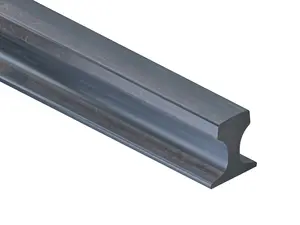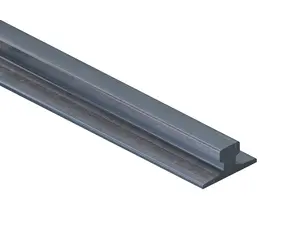Crane roadways rails
16 variantsIntroducing a range of crane rails designed for precision, durability and resistance to heavy use.
The crane rail plays a key function in any crane system. As an essential component of crane infrastructure, it must be made of the best materials, ensuring the stability and reliability of cranes' movement, even under load.
Characteristics of crane rails
Crane rails play a key role in crane structures, providing the necessary support and guidance for moving parts of the crane, such as overhead cranes and hoists. An important aspect of these rails is their strength and ability to withstand heavy loads and extreme conditions, which is crucial in heavy industry and construction.
The production of crane rails involves several steps, starting with the selection of a suitable material, which is usually high-strength steel. The process involves hot rolling, which ensures uniformity of the metal's structure and optimal mechanical properties. The final step is often heat treatment, increasing compressive strength and wear resistance, which is essential in high-stress environments. The rails are cut to the desired lengths and beveled if necessary.
Features and advantages of crane rails
Features of crane rails:
- High material strength - the use of high-strength steel ensures resistance to heavy loads.
- Precision machining - guarantees cutting to desired lengths and beveling of rails.
- Heat treatment - increases compressive strength and wear resistance.
- Resistance to extreme conditions - rails are designed to withstand harsh environmental conditions, including extreme temperatures and humidity.
Advantages of crane rails:
- Improved operating efficiency - precise guidance of cranes ensures faster and safer operation.
- Durability - resistance to wear and environmental conditions extends the life of the rails.
- Safety - the strength and stability of the rails increase the safety of crane operations.
- Cost optimization - less maintenance and longer life translate into lower operating costs.
Crane rail profiles
We offer crane rails with profiles A45, A55, A65/SD65, A75/SD75, A100/SD100, A120, A150 and crane sub-rails SP100 and SP120.
- A45 - this crane rail of smaller size is ideal for light applications. It features good strength, but its smaller size limits its load capacity.
- A55 - this profile is versatile, providing better load capacity than A45 while maintaining a moderate weight. It is ideal for medium-duty applications.
- A65/SD65 - a profile designed for heavier applications. Its heavier weight and dimensions provide better stability, but may require a stronger support structure.
- A75/SD75 - this profile is even larger and heavier, ideal for very heavy applications. Its weight and size provide exceptional stability, but at the cost of greater structural requirements.
- A100/SD100 - a profile designed for the heaviest industrial applications. It provides superior stability and load carrying capacity, but requires specialized installation and maintenance.
- A120 - a profile with even higher load capacity, used in particularly demanding environments. However, its size and weight are significant.
- A150 - the largest and heaviest profile, designed for extreme applications. Its size and weight require specialized handling and design.
- SP100 - a special profile that provides good load-bearing properties at a moderate weight. It is well balanced in terms of strength and structural requirements.
- SP120 - like SP100, it has good load carrying capacity at moderate weight. It is more suitable for heavier applications than SP100.
Steel grades
We offer crane rails in R260, 700 and 900 steel.
R260
Features:
- R260 is a low-carbon steel that has good strength and wear resistance.
Advantages:
- Excellent for standard rail applications.
- Good balance between strength and cost.
Disadvantages:
- May not be strong enough for the heaviest applications.
700
Features:
- 700 steel is less strong than R260, but has good tensile strength.
Advantages:
- Ideal for heavier applications where greater strength is required.
Disadvantages:
- Higher cost compared to R260.
900
Features:
- Very high quality steel, used in the most demanding applications.
Advantages:
- Provides superior strength and wear resistance.
Disadvantages:
- Much more expensive than other steels, used only where absolutely necessary.
Applications of crane rails
Overhead crane rails are a key component in crane systems, enabling the precise and safe movement of heavy loads in industrial spaces. They serve as the primary guiding element for overhead cranes and other lifting equipment, such as winches and crane carts. These rails must exhibit high load strength and resistance to external factors such as temperature changes and chemical influences.
These rails are used in various industrial sectors, including metallurgy, shipyards, warehouses, logistics centers and construction. Their role is to ensure the stable and smooth movement of overhead cranes and other equipment, which is crucial to the efficiency of industrial operations and the safety of workers.
Advice for investors
- Select the right profile - choose a crane rail profile that meets the specifics and operational requirements of your project. Consider load capacity, length and environmental conditions.
- Evaluate the quality of the material - make sure the rails you choose are made of high-quality steel that meets industry standards. Compressive strength and wear resistance are key parameters.
- Consult with experts - consult engineers or crane specialists to assess whether the type of rails you choose are suitable for your needs.
- Maintenance planning - consider aspects of maintenance and ease of access to rails for inspections and possible repairs.
- Total cost analysis - include in your evaluation not only the cost of purchase, but also installation, maintenance and possible repairs.
Storage of crane rails
Proper storage of crane rails is key to maintaining their quality and functionality. Our recommendations:
- Horizontal stacking - crane rails should be stored horizontally on specially designed racks to ensure stability and prevent deformation .
- Separation of different types and sizes - different types and sizes of rails should be stored separately to avoid confusion and damage.
- Protection from the elements - store rails in a dry and well-ventilated place, protecting them from moisture, corrosion and extreme temperatures.
- Protection from mechanical damage - make sure rails are adequately protected from impacts or other mechanical damage.
- Easy access and identification - rails should be easily accessible and properly labeled for easy identification.
- Regular inspection - inspect the condition of crane rails stored in the warehouse to prevent degradation.
Did you know.
- Overhead crane rails have been used for more than a century in industry, evolving from simple designs to advanced systems supporting heavy cranes.
- Precision in the manufacture of crane rails is key to ensuring smooth crane movement and minimizing wear.
- Modern technologies, such as heat treatment and the use of special alloys, significantly increase the strength and durability of crane rails.
- The development of maintenance technologies, such as special protective coatings, significantly extends the service life of crane rails under harsh operating conditions.
Crane rails - why with us?
The advantage of buying crane rails from our wholesaler is the certainty that you are getting a product that is perfectly adapted to the modern needs of the industry. The crane rails we offer are a guarantee of smooth movement, minimization of vibrations and extended service life. These characteristics translate directly into economic and operational benefits for any plant.
We invite you to take advantage of our offer.
FAQ
How much does a crane rail weigh?
The weight of a crane rail depends on its type, dimensions and the material used. Different rail profiles and lengths have different weights. In practice, the most common crane rail weight is given in kilograms per running meter (kg/m). For accurate information on the weight of a particular crane rail, refer to the manufacturer's specifications or product catalog.
For example, if the manufacturer's catalog states that a particular crane rail weighs 60 kg/m, this means that a running meter of this rail weighs 60 kg. Therefore, if you need 10 meters of such rail, the entire rail will weigh 600 kg.


